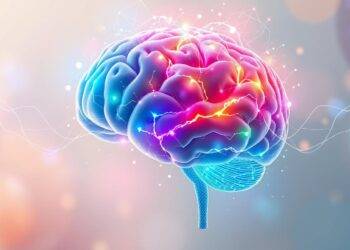Did you know that your physical movements can significantly influence your thoughts, decisions, and behaviors? Research has shown that the way we move our body affects our mind and brain processes.
This concept challenges traditional views of the mind as separate from the body. Instead, it suggests that cognition extends beyond the brain to include the entire body and its interactions with the environment.
By understanding how our physical movements and bodily states directly influence our thoughts and behaviors, we can unlock new perspectives on learning, memory, language, and problem-solving.
Key Takeaways
- The body plays an active role in shaping our thoughts and behaviors.
- Physical movements can influence our cognitive processes.
- Cognition is not limited to the brain but involves the entire body.
- This concept offers new insights into learning and memory.
- Understanding this relationship can improve daily life and emotional regulation.
The Mind-Body Connection: Beyond Cartesian Dualism
The mind-body connection has been a subject of interest, moving beyond the conventional Cartesian dualism that separates mental and physical processes. This perspective has led to a deeper understanding of how our bodily experiences influence our cognitive processes.
Challenging the Brain-Centric View of Cognition
The traditional brain-centric view of cognition posits that the brain is the primary organ responsible for cognitive processes. However, proponents of embodied cognition argue that this view is overly simplistic. They suggest that cognition is not solely the product of brain activity but is significantly influenced by the body’s interactions with the environment. Our sensory and motor systems play a crucial role in shaping our cognitive processes, from perception to higher-order thinking.
Research has shown that bodily states can affect cognitive processes. For instance, being in a certain physical posture can influence one’s emotional state and, consequently, one’s cognitive processing. This bidirectional relationship between bodily states and cognitive processes underscores the integrated nature of mind and body.
| Cognitive Process | Bodily Influence | Environmental Factor |
|---|---|---|
| Perception | Sensory input | Environmental stimuli |
| Emotional State | Posture and facial expressions | Social interactions |
| Decision-Making | Motor responses | Physical environment |

The Integrated Nature of Thought and Physical Experience
The integrated nature of thought and physical experience is a cornerstone of embodied cognition. This perspective posits that our physical experiences provide the foundation for abstract thought and conceptual understanding. For example, understanding language is not just a matter of processing abstract symbols; it involves embodied simulation, where we mentally simulate physical actions when processing action-related words.
Moreover, emotional states manifest as bodily sensations that directly influence cognitive processing and judgment. The dynamic interplay between the body, mind, and environment creates a system where cognition emerges from their interaction. This understanding has significant implications for how we approach cognitive development, learning, and even therapy.
By recognizing the interconnectedness of the mind and body, we can better appreciate how our physical experiences shape our thought patterns and conceptual frameworks. This knowledge can be applied in various fields, from education to clinical settings, to enhance our understanding of human cognition and behavior.
What Is Embodied Cognition?
As we delve into the realm of embodied cognition, it becomes clear that this theory offers a novel perspective on how our bodily interactions influence our cognitive functions. Embodied cognition posits that the mind is not solely located in the brain but is distributed throughout the body and shaped by its interactions with the environment.
Core Principles and Definitions
Embodied cognition is grounded in the idea that cognitive processes, including perception, attention, memory, and decision-making, are deeply intertwined with bodily experiences. This approach challenges the traditional Cartesian model, which views the mind and body as separate entities.
The core principles of embodied cognition can be summarized as follows:
- The mind is not just located in the brain but is distributed throughout the body.
- Cognitive processes are shaped by bodily experiences and sensorimotor interactions.
- The environment plays a crucial role in shaping cognition.
To illustrate the differences between traditional cognitive science and embodied cognition, let’s examine the following comparison:
| Aspect | Traditional Cognitive Science | Embodied Cognition |
|---|---|---|
| View of Cognition | Computation-based, abstract symbol processing | Ground in physical experience, action-based |
| Role of the Body | Peripheral, secondary to brain processes | Central, integral to cognitive processes |
| Methodology | Laboratory experiments, controlled environments | Naturalistic observations, real-world contexts |
How Embodied Cognition Differs from Traditional Cognitive Science
Embodied cognition diverges from traditional cognitive science in several key ways. Firstly, it rejects the computational model of the mind, which views cognition as the processing of abstract symbols. Instead, embodied cognition sees cognition as grounded in sensorimotor experiences.
Furthermore, embodied cognition challenges the notion that the brain is the sole organ of cognition. By emphasizing the role of the body and environment, this approach provides a more holistic understanding of cognitive processes.

The implications of embodied cognition are far-reaching, influencing fields such as psychology, neuroscience, philosophy, and education. By recognizing the intricate relationship between the mind, body, and environment, we can develop more effective strategies for improving cognitive function and overall well-being.
The Historical Evolution of Embodied Cognition
The historical development of embodied cognition is a rich narrative that spans multiple disciplines, weaving together threads from philosophy, psychology, neuroscience, and artificial intelligence. This evolution reflects a growing recognition of the intricate relationships between the mind, body, and environment.
Philosophical Roots: Phenomenology and Pragmatism
Embodied cognition has deep roots in philosophical traditions that emphasize the importance of embodied experience. Phenomenology, particularly the work of Maurice Merleau-Ponty, has been instrumental in shaping the field. Merleau-Ponty’s concept of the “lived body” underscores the idea that our experience of the world is fundamentally grounded in our bodily existence. Pragmatism, with its focus on practical action and experimentation, has also contributed significantly to the development of embodied cognition.
The influence of phenomenology and pragmatism can be seen in the emphasis on sensorimotor contingencies and the role of the body in shaping cognitive processes. These philosophical underpinnings have encouraged researchers to move beyond traditional computational models of cognition, embracing a more holistic understanding of the mind-body-environment system.
| Philosophical Tradition | Key Concepts | Influence on Embodied Cognition |
|---|---|---|
| Phenomenology | Lived body, embodied experience | Emphasis on bodily existence in shaping cognition |
| Pragmatism | Practical action, experimentation | Focus on sensorimotor contingencies and embodied cognition |
From Computational Models to Embodied Approaches
The shift from computational models of cognition to more embodied approaches has been a gradual process, influenced by various scientific and technological developments. In the 1950s and 1960s, the rise of informatics and artificial intelligence led to the dominance of computationalist views of cognition. However, these models were later challenged by researchers such as J.J. Gibson, who proposed an ecological psychology that emphasized direct perception and organism-environment interactions.

The 1980s saw the emergence of connectionism, which moved away from symbolic processing toward more biologically-inspired neural network models. Robotics research in the 1990s further demonstrated the practical advantages of embodied approaches to artificial intelligence. Advances in neuroscience, particularly the discovery of mirror neurons, provided biological evidence for embodied theories.
Researchers like Francisco Varela, Eleanor Rosch, and Evan Thompson developed the enactive approach, which emphasizes the role of the lived body in shaping cognitive processes. Over the past three decades, embodied cognition has gradually gained mainstream acceptance in cognitive science.
- The development of ecological psychology by J.J. Gibson challenged traditional information processing models.
- Connectionism in the 1980s introduced biologically-inspired neural network models.
- Robotics research in the 1990s demonstrated the practical advantages of embodied approaches.
- Advances in neuroscience provided biological evidence for embodied theories.
The Three Pillars of Embodied Cognition Theory
The theory of embodied cognition is structured around three critical pillars that redefine how we understand cognitive processes. These pillars not only challenge traditional views of cognition but also provide a comprehensive framework for understanding the intricate relationship between the body, mind, and environment.
Conceptualization: How Bodies Shape Our Concepts
Embodied cognition posits that our bodily experiences play a crucial role in shaping our concepts and understanding of the world. This perspective suggests that cognitive processes are deeply rooted in sensorimotor experiences, influencing how we perceive and categorize objects and events. For instance, the way we interact with objects in our environment affects our conceptualization of their properties and functions.
Research has shown that bodily postures and gestures can influence cognitive processes, such as memory recall and problem-solving. For example, adopting an expansive body posture can enhance feelings of power and confidence, thereby affecting decision-making processes.
Replacement: Moving Beyond Computational Models
The second pillar, replacement, argues for moving beyond traditional computational models of cognition. Embodied cognition theory suggests that the mind is not just a computer processing information but is deeply intertwined with the body’s interactions with the environment. This view challenges the idea that cognition can be fully understood through computational models alone.
By considering the role of the body in cognitive processes, researchers can develop more nuanced models that account for the dynamic interplay between the brain, body, and environment. This approach has led to a greater understanding of how cognitive offloading—the process of using the environment to reduce cognitive load—plays a significant role in everyday cognition.
| Pillar | Description | Impact on Cognition |
|---|---|---|
| Conceptualization | Bodies shape our concepts through sensorimotor experiences | Influences perception and categorization |
| Replacement | Moving beyond computational models to include bodily interactions | Leads to more nuanced understanding of cognition |
| Constitution | The body is part of the cognitive system | Extends the boundary of cognition beyond the brain |
Constitution: The Body as Part of the Cognitive System
The third pillar, constitution, makes the radical claim that the body is not just causally related to cognition but is constitutively part of the cognitive system itself. This perspective challenges the traditional boundary of cognition, suggesting that cognitive processes extend beyond the brain to include the body and aspects of the environment.
Studies on tool use and gesture have provided evidence that the body schema can incorporate external objects, effectively making them part of the cognitive system. This understanding has significant implications for how we view the role of the body in cognition and highlights the distributed nature of cognitive processes across the brain, body, and world.
By embracing these three pillars, embodied cognition theory offers a comprehensive and nuanced understanding of cognitive processes, emphasizing the integral role of the body in shaping our thoughts, behaviors, and interactions with the world.
The Science Behind Embodied Cognition
Recent findings in neuroscience and psychology have provided substantial evidence for the embodied cognition theory. This theory suggests that cognitive processes are not solely the domain of the brain but are deeply influenced by the body’s interactions with the environment. The integration of bodily experiences into our understanding of cognition has far-reaching implications for various fields, from education to clinical psychology.
Neurological Evidence Supporting Embodiment
Studies using neuroimaging techniques have shown that cognitive tasks often engage sensorimotor areas of the brain. For instance, research has demonstrated that reading action sentences can activate the corresponding motor areas in the brain, a phenomenon known as embodied simulation. This neural overlap between cognitive and motor processes underscores the embodied cognition theory’s assertion that the body plays a crucial role in shaping our cognitive experiences.
Moreover, the concept of embodied metaphors further illustrates how bodily experiences influence abstract thought. For example, the notion that the future is “forward” and the past is “backward” is not just a linguistic convention but reflects a deeper, embodied understanding of time. This metaphorical mapping of bodily experiences onto abstract concepts is a fundamental aspect of how we comprehend and navigate the world.
Experimental Research and Key Findings
Experimental research has provided a wealth of evidence supporting the embodied cognition theory. For example, a study by Martin and Schwartz (2005) found that children were more successful at calculating ¼ of 8 when allowed to manipulate pie pieces than when they were only allowed to view the pieces. This finding highlights the importance of physical interaction with objects in enhancing mathematical understanding and problem-solving abilities.
Other experiments have demonstrated that bodily postures and facial expressions can significantly influence emotional judgments and memory recall. For instance, adopting a confident posture can enhance feelings of confidence and power, while making a smiling expression can improve mood. These findings illustrate how the body’s state can directly impact cognitive and emotional processes.
| Study | Task | Finding |
|---|---|---|
| Martin and Schwartz (2005) | Mathematical calculation | Children performed better when manipulating objects |
| Embodied simulation research | Reading action sentences | Activated corresponding motor areas in the brain |
| Emotional judgment studies | Bodily postures and facial expressions | Influenced emotional states and memory recall |
Furthermore, research on embodied cognition and subconscious mind reprogramming techniques has shown promising results in enhancing cognitive flexibility and overall well-being. By understanding how bodily states influence cognitive processes, individuals can leverage this knowledge to improve their mental and emotional states.
How Your Body Influences Your Thinking
The way we think is not just a product of our brain’s activity but is deeply intertwined with our bodily sensations and physical experiences. This understanding is rooted in the concept of embodied cognition, which posits that the mind is not only located in the brain but also distributed throughout the body and shaped by its interactions with the environment.
Embodied cognition challenges the traditional view of the mind-body dichotomy, suggesting instead that cognitive processes, including perception, decision-making, and memory, are influenced by the body’s sensorimotor experiences. This perspective emphasizes the importance of understanding how our bodily states and actions impact our thinking and behavior.
Sensorimotor Contingencies and Perception
The Sensorimotor Contingency (SMC) theory provides a foundational framework for understanding how our bodily movements and sensory experiences are intertwined. According to the SMC theory, “The experience of seeing occurs when the organism masters what we call the governing laws of sensorimotor contingency.” This theory underscores the active role of the body in perception, highlighting that our understanding of the world is not a passive reception of sensory input but an active process of exploring and interacting with our environment.
Sensorimotor contingencies refer to the lawful relations between our actions and the resulting sensory changes. For instance, when we move our eyes or head, the visual input changes in predictable ways. Mastering these contingencies is essential for perception; it’s through learning and adapting to these sensorimotor relationships that we come to understand and navigate our world.
- Our ability to perceive objects and their properties is influenced by our capacity to move and interact with them.
- The integration of sensory and motor information allows for a richer and more nuanced understanding of our environment.
- Research has shown that sensorimotor experiences can significantly impact our cognitive processes, including attention, memory, and decision-making.
The Role of Physical States in Decision-Making
Physical states and bodily sensations play a crucial role in decision-making processes. Emotions, which are fundamentally embodied experiences, guide and constrain our reasoning and choices. The somatic marker hypothesis, proposed by Antonio Damasio, suggests that bodily feelings associated with past experiences guide current decisions, serving as a critical link between emotion, cognition, and action.
Research has demonstrated that various physical sensations can significantly impact judgment and risk assessment. For example, holding a warm drink versus a cold one can influence interpersonal judgments, with warmth being associated with social warmth. Similarly, physical cleanliness can affect moral judgments, with sensations of physical purity influencing perceptions of moral purity.
“Bodily states can unconsciously influence our evaluations and preferences, highlighting the complex interplay between the body and cognition.”
Practical applications of these insights can improve decision-making by increasing awareness of bodily influences. By recognizing how physical states and actions impact our choices, we can develop strategies to mitigate unwanted biases and make more informed decisions.
- Being aware of our physical state and its potential impact on our decision-making can help us make more rational choices.
- Understanding the role of embodied cognition in decision-making can inform the development of new approaches to decision support systems.
- Recognizing the influence of bodily sensations on our judgments can encourage a more holistic approach to personal and professional development.
Language and Embodied Cognition
Our ability to comprehend and process language is significantly influenced by our bodily experiences and sensorimotor capabilities. This understanding is rooted in the theory of embodied cognition, which posits that cognitive processes, including language, are deeply grounded in our physical interactions with the world.
The relationship between language and embodied cognition is complex and multifaceted. It suggests that the way we understand and use language is not just a function of abstract cognitive processes but is closely tied to our bodily experiences and the way we perceive the world around us.
Metaphors as Bodily Expressions of Abstract Concepts
One of the key areas where the influence of embodied cognition on language is evident is in the use of metaphors. Cognitive scientist George Lakoff argues that many abstract concepts are understood through metaphors that are rooted in bodily experiences. For example, understanding the concept of “grasping an idea” is linked to the physical act of grasping an object.
Metaphors serve as a bridge between concrete physical experiences and abstract concepts, enabling us to comprehend and communicate complex ideas more effectively. This metaphorical extension of bodily experiences into the realm of abstract thought underscores the embodied nature of language and cognition.
- Metaphors like “time is money” or “life is a journey” reflect how our understanding of abstract concepts is grounded in everyday physical experiences.
- The use of spatial metaphors (e.g., “up” for positive and “down” for negative) demonstrates how our bodily orientation influences our language.
How Physical Experience Shapes Linguistic Understanding
Research has shown that physical experiences directly impact how we understand and process language. For instance, studies have found that reading or hearing action words (e.g., “kick,” “pick”) activates the motor regions of the brain associated with performing those actions. This activation suggests that language comprehension involves a mental simulation of the described actions using our sensorimotor systems.
Furthermore, physical actions that are congruent with the content of language can facilitate comprehension and memory. For example, performing a gesture related to the action described in a sentence can enhance understanding and recall of that sentence.
“The mind is not merely located in the brain, but is distributed throughout the body and shaped by its interactions with the environment.” – This perspective highlights the integral role of bodily experiences in cognitive processes, including language.
The embodied view of language challenges traditional symbolic or amodal theories of linguistic meaning, suggesting instead that language is grounded in our sensorimotor experiences. This understanding has practical implications for language education, suggesting that incorporating physical movement can enhance language learning.
Key implications of embodied cognition for language include:
- Language learning can be enhanced by incorporating physical movement and gestures.
- Understanding of abstract concepts is facilitated through metaphorical extensions of bodily experiences.
- Physical limitations or expertise can influence language comprehension, as seen in the different ways athletes and non-athletes understand sports-related language.
Memory Through the Lens of Embodiment
Our bodies play a crucial role in shaping our memories, affecting how we recall and process information. The concept of embodied cognition offers a fresh perspective on understanding memory, suggesting that it’s not just a cerebral activity but is deeply intertwined with our bodily experiences and states.
Episodic Memory and Physical Context
Episodic memory, which involves recalling specific events and experiences, is significantly influenced by the physical context in which these events occurred. Research has shown that recreating the bodily postures or movements from the original learning context can trigger associated memories, highlighting the embodied nature of memory retrieval.
The enactment effect is a phenomenon where performing actions during learning leads to better memory retention compared to merely reading or observing. This effect underscores the importance of bodily engagement in memory formation, suggesting that physical activity enhances the encoding and retrieval of information.
Body-Based Cues in Memory Retrieval
Bodily states and movements serve as powerful cues for memory retrieval. Techniques such as the method of loci, which utilizes spatial navigation and bodily movement, have been used to enhance recall. This method involves visualizing a familiar place and associating the items to be remembered with specific locations, leveraging the body’s spatial memory capabilities.
Emotional states, fundamentally embodied, also play a crucial role in memory retrieval. They can serve as memory cues that either enhance or impair the ability to recall information. Understanding the embodied dimensions of emotional states can provide insights into how they influence memory processes.
Furthermore, physical artifacts and environmental features can function as external memory cues, reducing cognitive load and facilitating memory retrieval. The interplay between the body, environment, and memory highlights the complex systems involved in cognitive processes.
Muscle memory and procedural learning are examples where physical skills are stored in the body rather than as explicit memories. This aspect of embodied cognition illustrates how different types of information are processed and retained through bodily experiences.
The embodied perspective on memory retrieval offers practical strategies for improving recall in educational and everyday contexts. By considering the role of the body in memory, individuals can develop more effective learning techniques and memory aids.
Moreover, understanding memory disorders through the lens of embodiment can lead to novel approaches in their treatment. Recognizing the embodied dimensions of memory can provide new avenues for therapeutic interventions.
Emotion as an Embodied Process
Embodied cognition reveals that emotions are not just mental states but are significantly influenced by our bodily conditions. This perspective challenges the traditional view that emotions are solely the result of brain activity, instead suggesting that the body plays a crucial role in emotional experience.
The Physical Foundations of Emotional Experience
The relationship between bodily states and emotions is bidirectional. On one hand, emotions can cause changes in our bodily states, such as increased heart rate or sweating. On the other hand, our bodily states can also influence our emotional experiences. For instance, the facial feedback hypothesis proposes that facial expressions can generate corresponding emotional feelings. Studies have shown that when individuals are induced to smile, they report feeling happier, while frowning can lead to feelings of sadness.
Posture is another bodily state that significantly affects emotional processing. Research has demonstrated that adopting expansive postures can increase confidence and emotional resilience, while contracted postures can have the opposite effect. These findings suggest that by modifying our bodily states, we can influence our emotional experiences.
- Adopting expansive body postures can boost confidence and reduce stress.
- Facial expressions can influence emotional states, with smiling associated with happiness.
- Bodily feedback mechanisms play a crucial role in emotional regulation.
How Bodily States Influence Emotional Processing
Bodily states can be manipulated to induce or reduce specific emotions. For example, changing breathing patterns or muscle tension can significantly impact emotional states. Physical exercise is another powerful tool that affects mood through multiple embodied pathways, including endorphin release and improved body image.
Emotional contagion, the phenomenon where we unconsciously mimic others’ emotional states, is also influenced by bodily expressions and postures. By becoming more aware of our bodily states and deliberately modifying them, we can develop practical strategies for improving emotional well-being.
The bidirectional relationship between bodily states and emotions underscores the importance of considering the body in emotional processing. By understanding how our bodily states influence our emotional experiences, we can harness this knowledge to develop novel interventions for emotional regulation.
In conclusion, emotions are not just abstract mental states but are deeply rooted in our bodily experiences. Recognizing the interplay between the body and emotions can empower individuals to take control of their emotional well-being through targeted physical interventions.
Movement and Cognitive Development
Movement is not just a physical activity; it’s a catalyst for cognitive development across the lifespan. The intricate relationship between physical movement and cognitive function has been a subject of increasing interest in research.
Understanding how movement influences cognitive development can provide insights into improving learning outcomes and cognitive health. This section will explore the connection between motor skills and intellectual growth in children, as well as the impact of physical activity on cognitive performance across the lifespan.
Motor Skills and Intellectual Growth in Children
Research has shown that motor skills in children are closely linked to their intellectual growth. The development of fine and gross motor skills is not just a physical milestone but also a cognitive one. Studies have indicated that children with better motor skills tend to perform better academically.
- Motor skills development is associated with improved cognitive functions, including attention and memory.
- Children who engage in regular physical activity tend to have better concentration and academic performance.
- The integration of movement into learning activities can enhance retention and understanding of new concepts.
Physical Activity and Cognitive Performance
Physical activity has been consistently shown to enhance cognitive performance across various age groups. Exercise improves blood flow to the brain, boosting cognitive functions such as attention, working memory, and executive function.
The benefits of physical activity on cognition are not limited to children; adults and older adults also experience cognitive improvements with regular exercise. This includes enhanced executive function and a reduced risk of cognitive decline.
- Regular aerobic exercise has been shown to improve memory and executive function in both children and adults.
- Strength training and coordination exercises also contribute to cognitive health by promoting neuroplasticity.
- Incorporating movement breaks during learning sessions can improve attention and memory consolidation.
By understanding the role of movement in cognitive development and performance, individuals can harness the power of physical activity to improve their learning and cognitive health. This knowledge challenges traditional sedentary educational and work environments, promoting a more integrated approach to physical and cognitive well-being.
Social Cognition and Embodiment
Social cognition is not just about thinking; it’s deeply rooted in our bodily experiences and interactions. The way we understand others, empathize with them, and form social connections is significantly influenced by our embodied experiences.
Understanding Others Through Bodily Simulation
One of the key aspects of social cognition is our ability to understand others through bodily simulation. When we observe someone performing an action, our brain simulates that action, allowing us to understand their intentions and emotions. This process is fundamentally embodied, as it involves the activation of our own motor and sensory systems.
Embodied empathy is a concept that highlights how we physically simulate others’ emotional states in our own bodies. This simulation is not just a cognitive process but a deeply bodily one, involving changes in our physiological state that mirror those of the person we are empathizing with.
For instance, when we see someone experiencing pain, our brain areas associated with pain perception are activated, allowing us to empathize with their experience. This embodied empathy is crucial for forming and maintaining social connections.
Embodied Aspects of Empathy and Social Connection
Empathy and social connection are not just cognitive processes; they are deeply rooted in our bodily interactions. Physical synchrony in movement and physiology, such as matched breathing or heart rates, strengthens social bonds. Touch and physical proximity also play a crucial role in activating neural systems that promote trust and reduce stress.
Cultural practices involving synchronized movement, such as dance or music, leverage embodied mechanisms to create group cohesion. These practices demonstrate how shared physical experiences can create stronger social connections than purely cognitive interactions.
| Embodied Mechanism | Effect on Social Connection | Example |
|---|---|---|
| Physical Synchrony | Strengthens social bonds | Synchronized dance or music |
| Touch and Proximity | Promotes trust and reduces stress | Hugging or holding hands |
| Embodied Empathy | Enhances understanding and empathy | Mirroring emotional expressions |
Understanding the embodied aspects of social cognition has significant implications for various fields, including therapy, education, and virtual interaction design. By recognizing the importance of bodily experiences in social interactions, we can develop more effective strategies for enhancing social connections and empathy.
Practical strategies for enhancing social connections through awareness of embodied dimensions of interaction include practicing mindfulness, engaging in synchronized physical activities, and being more aware of our bodily responses to others.
Embodied Cognition in Everyday Life
The connection between our bodily experiences and cognitive processes is more than theoretical; it has real-world applications. As we explore the practical implications of embodied cognition, we can gain a deeper understanding of how our daily lives are influenced by the intricate relationship between our bodies and minds.
Environmental Influences on Cognition
Our surroundings play a significant role in shaping our thoughts and behaviors. The design of our physical environments can either hinder or enhance our cognitive abilities. For instance, a cluttered workspace can lead to a cluttered mind, while a well-organized and aesthetically pleasing environment can foster creativity and productivity.
The concept of situated cognition emphasizes that our cognitive processes are inherently linked to the cultural and social contexts in which they occur. This understanding can inform the design of spaces that support cognitive tasks. For example, incorporating natural elements into office design can improve cognitive functioning and overall well-being.
| Environmental Factor | Cognitive Impact |
|---|---|
| Natural Light | Improves mood and cognitive function |
| Clutter | Negatively affects focus and productivity |
| Aesthetic Design | Enhances creativity and overall well-being |
Practical Applications in Daily Decision-Making
Embodied cognition offers several practical strategies for improving daily decision-making. By being more aware of our bodily states and how they influence our judgments, we can make more balanced decisions. For example, recognizing the impact of physical fatigue on our decision-making processes can prompt us to postpone important decisions until we are more alert.
Strategic use of physical movements and postures can also enhance decision quality. Techniques such as “thinking with your hands” through activities like drawing or crafting can make complex problems more manageable. Moreover, timing decisions with bodily rhythms, such as energy levels or circadian cycles, can lead to better outcomes.
- Awareness of bodily states can lead to more balanced judgments
- Physical movements and postures can be used to enhance decision quality
- Environmental design can nudge behavior and decision-making in beneficial directions
By applying these principles of embodied cognition, individuals can develop more effective strategies for tackling daily challenges and improving their overall cognitive performance.
Critiques and Limitations of Embodied Cognition
Embodied cognition, a paradigm that emphasizes the role of the body in cognitive processes, has sparked intense debate and scrutiny. While it offers a compelling alternative to traditional views of cognition, it is essential to examine the critiques and limitations of this theory.
Scientific Challenges to the Embodiment Thesis
The embodied cognition theory faces several scientific challenges, primarily centered around the extent to which bodily experiences influence cognitive processes. Some researchers argue that the evidence supporting embodied cognition is not yet conclusive, and more rigorous studies are needed to substantiate its claims.
One of the significant challenges is the distinction between “strong” and “weak” versions of embodied cognition theory. The strong version posits that cognition is entirely dependent on bodily experiences, while the weak version suggests that bodily experiences influence cognition but are not the sole determinants. Understanding this distinction is crucial for addressing the criticisms leveled against embodied cognition.
Neuropsychological evidence plays a crucial role in understanding the limitations of embodied cognition. The currently available evidence is decisive: modality-specific content can be disrupted while conceptual processing remains intact. This suggests that cognitive processes may be more complex and multifaceted than embodied cognition alone can explain.
Balancing Embodied and Abstract Cognitive Processes
A more nuanced approach to understanding cognition involves balancing embodied and abstract cognitive processes. Hybrid models that propose both embodied and amodal representations working together in cognitive processing offer a promising direction. These models acknowledge that different cognitive tasks may rely on embodied or abstract processes to varying degrees.
The “symbol grounding problem” is another critical area where embodied approaches can complement abstract cognitive processes. Embodied cognition addresses the connection between abstract symbols and physical reality, providing a more comprehensive understanding of how we process information.
By examining how computational models incorporate embodied principles while maintaining abstract processing capabilities, researchers can develop a more integrated understanding of cognition. This balanced perspective can help resolve theoretical tensions in cognitive science, ultimately enhancing our understanding of human cognition.
Applications of Embodied Cognition
As research in embodied cognition continues to grow, its practical applications are becoming more evident in diverse areas such as education, sports, and therapy. The understanding that cognition is deeply rooted in bodily experiences is leading to innovative approaches in various fields.
Education and Learning Design
Embodied cognition is transforming the way we approach learning and education. By incorporating bodily experiences and movement into educational settings, learning can become more effective and engaging. For instance, studies have shown that gestures can enhance memory recall and comprehension. Educators are now designing curricula that integrate physical activity with academic content, thereby improving students’ understanding and retention of material.
Some key strategies in embodied learning include:
- Using gestures to reinforce learning concepts
- Incorporating movement into lesson plans
- Utilizing interactive simulations to teach complex subjects
Clinical Settings and Therapy
In clinical settings, embodied cognition is being applied to develop novel therapeutic approaches. For example, therapies that focus on bodily awareness and movement are being used to help individuals recover from neurological injuries or manage symptoms of psychological disorders. Techniques such as dance therapy and mindfulness-based interventions are gaining recognition for their benefits in improving cognitive and emotional well-being.
Embodied cognition principles are also being used to enhance rehabilitation programs. By understanding how bodily experiences influence cognition, therapists can design more effective rehabilitation protocols that address both physical and cognitive aspects of recovery.
Sports and Performance Enhancement
In the realm of sports and performance, embodied cognition is revolutionizing training methods. Coaches and athletes are leveraging the understanding that mental simulation and motor imagery can activate the same neural pathways as physical practice. This knowledge is being used to enhance skill acquisition and performance.
Some of the key applications in sports include:
- Mental simulation and motor imagery to enhance skill acquisition
- External focus of attention to improve performance
- Environmental design to create optimal affordances and constraints for training
- Interoception to optimize pacing and energy management during performance
By applying embodied cognition principles, athletes and performers can gain a competitive edge and achieve higher levels of performance. These principles are not limited to sports but can also be applied to other performance domains such as music and public speaking.
The Future of Embodied Cognition Research
The field of embodied cognition is experiencing a paradigm shift, fueled by new technologies and methodologies. This transformation is not only advancing our understanding of cognition but also opening new avenues for research and application. As embodied cognition continues to evolve, it’s becoming increasingly clear that the future of this field lies at the intersection of interdisciplinary collaboration and technological innovation.
Emerging Technologies and Methodologies
Recent advancements in technology are significantly enhancing the study of embodied cognition. Techniques such as motion capture, virtual reality (VR), and wearable sensors are providing researchers with more sophisticated tools to investigate the intricate relationships between body movement, sensory experience, and cognitive processes. For instance, VR environments allow researchers to manipulate and control the physical context of cognitive tasks in ways that were previously impossible, offering new insights into how our surroundings influence thought and behavior.
Moreover, advancements in neuroimaging techniques, such as functional magnetic resonance imaging (fMRI) and electroencephalography (EEG), are enabling more precise examinations of the neural mechanisms underlying embodied cognition. These technologies are helping to elucidate how different parts of the brain communicate during various cognitive tasks and how bodily states affect neural activity.
| Technology | Application in Embodied Cognition | Potential Impact |
|---|---|---|
| Motion Capture | Analyzing movement patterns during cognitive tasks | Understanding how specific movements influence cognition |
| Virtual Reality (VR) | Creating controlled, immersive environments for cognitive experiments | Revealing how environmental factors shape cognitive processes |
| Wearable Sensors | Monitoring physiological responses during cognitive tasks | Elucidating the role of bodily states in cognitive processing |
Interdisciplinary Approaches and New Frontiers
The future of embodied cognition research is also being shaped by increasing interdisciplinary collaboration. By integrating insights and methods from neuroscience, psychology, philosophy, robotics, and education, researchers are developing more comprehensive theories of cognition. For example, the convergence of embodied cognition and ecological psychology is leading to a more nuanced understanding of how organisms interact with their environments and how these interactions shape cognitive processes.
New frontiers in embodied cognition research include the study of cultural embodiment, which examines how cultural practices influence embodied cognitive processes, and developmental embodied cognition, which traces how embodied experiences shape cognitive growth from infancy. These emerging areas highlight the field’s expanding scope and its potential to inform a wide range of disciplines.
As embodied cognition continues to advance, it’s likely to have significant implications for our understanding of complex human capacities such as creativity and moral reasoning. By exploring how bodily experiences and environmental interactions contribute to these higher-order cognitive processes, researchers can develop more holistic models of human cognition.
The integration of embodied cognition with other fields, such as artificial intelligence and robotics, is also expected to drive innovation in areas like artificial general intelligence. By incorporating insights from embodied cognition, developers can create more sophisticated AI systems that better simulate human-like intelligence and adaptability.
Conclusion: Embracing the Thinking Body
The concept ofembodied cognitionbridges ancient wisdom and modern science, providing a comprehensive framework for understanding the complex interplay between bodily experiences and cognitive processes. This approach to understanding human thought and behavior emphasizes the integral role of thebodyin shaping ourcognitive processes.
As we synthesize the key insights fromembodied cognitionresearch, it becomes evident that recognizing thebody’srole incognitiontransforms our self-understanding as thinking beings. This perspective not only challenges traditional views of themind-bodydichotomy but also offers a more holistic and biologically grounded view of humancognitionthan purely computational models.
By embracing ourembodied nature, we can develop more effective approaches toeducation,health, andpersonal development. For instance, incorporating physical activity into learning environments can enhance cognitive development and improve academic performance. You can explore more about applying embodied cognition principles in personal development by visiting our resource onembodying your goals.
Theembodied cognition theoryhas significant philosophical implications, particularly concerning questions aboutconsciousness,free will, andhuman uniqueness. It encourages a shift in our understanding of themindand its intricate relationship with thebody, suggesting that ourthinkingis not confined to the brain but is distributed throughout our bodily experiences.
Moreover, anembodiedperspective can help address contemporary challenges such asdigital overloadandsedentary lifestylesby promoting a more balanced and mindful approach to technology use and physical activity. Asembodied cognitiontheory continues to evolve, incorporating new evidence and addressing criticisms, it offers a promisingapproachto enhancing ourunderstandingof theworldand our place within it.
In conclusion,embodied cognitionprovides a profoundunderstandingof humancognitionthat is deeply rooted in our bodily experiences. By adopting this perspective, we can foster a more nuanced appreciation for the intricate interplay between themind,body, andworldaround us, ultimately enriching ourperspectiveson what it means to be human.
FAQ
What is the core idea behind embodied cognition?
The core idea is that the mind is not just located in the brain but is distributed throughout the body and shaped by its interactions with the environment.
How does embodied cognition differ from traditional views of cognition?
Unlike traditional views that focus primarily on the brain’s role in processing information, embodied cognition emphasizes the role of the body and its sensorimotor experiences in shaping cognitive processes.
Can you provide an example of how bodily states influence cognitive processes?
Research has shown that physical states, such as posture or facial expressions, can influence emotional processing and decision-making, illustrating how bodily states can affect cognition.
How does embodied cognition relate to language understanding?
Embodied cognition suggests that language comprehension is grounded in bodily experiences, with metaphors and abstract concepts being understood through their relation to physical experiences.
What are some practical applications of embodied cognition in everyday life?
Understanding embodied cognition can inform strategies for improving learning, decision-making, and social interactions by leveraging the interplay between bodily states and cognitive processes.
How does embodied cognition impact our understanding of memory?
Embodied cognition highlights the role of physical context and body-based cues in memory retrieval, suggesting that memory is not just a product of the brain but is also influenced by bodily experiences.
What are the implications of embodied cognition for education and learning design?
Embodied cognition suggests that incorporating physical activity and movement into learning environments can enhance cognitive development and improve learning outcomes.
How does embodied cognition relate to emotional experience?
Embodied cognition posits that emotional experiences are rooted in bodily states and that understanding the physical foundations of emotion can provide insights into emotional processing.




























































